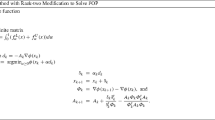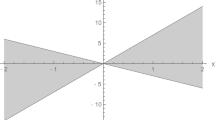Abstract
In this study, a quasi-Newton method is developed to obtain efficient solutions of interval optimization problems. The idea of generalized Hukuhara differentiability for multi-variable interval-valued functions is employed to derive the quasi-Newton method. Through an inverse-Hessian approximation with rank-two modification, the proposed technique sidesteps the high computational cost for the computation of inverse-Hessian in Newton method for interval optimization problems. The rank-two modification of inverse-Hessian approximation is applied to generate the iterative points in the quasi-Newton technique. A sequential algorithm and the convergence result of the derived method are also presented. It is obtained that the sequence in the proposed method has superlinear convergence rate. The method is also found to have quadratic termination property. Two numerical examples are provided to illustrate the developed technique.
Similar content being viewed by others
References
Bazaraa, M.S., Sherali, H.D., Shetty, C.M.: Nonlinear Programming: Theory and Algorithms, 3rd edn. Wiley, New York (2006)
Bhurjee, A.K., Panda, G.: Efficient solution of interval optimization problem. Math. Methods Oper. Res. 76(3), 273–288 (2012)
Boggs, P.T., Byrd, R.H., Schnabel, R.B.: Numerical optimization 1984. In: Proceedings of the SIAM Conference on Numerical Optimization. Boulder, Colorado, June 12–14, 1984, Vol. 20, Siam (1985)
Chakraborty, D., Ghosh, D.: Analytical fuzzy plane geometry II. Fuzzy Sets Syst. 243, 84–100 (2014)
Chalco-Cano, Y., Rufian-Lizana, A., Roman-Flores, H., Jimenez-Gamero, M.D.: Calculus for interval-valued functions using generalized Hukuhara derivative and applications. Fuzzy Sets Syst. 219, 49–67 (2013)
Chalco-Cano, Y., Silva, G.N., Rufian-Lizana, A.: On the Newton method for solving fuzzy optimization problems. Fuzzy Sets Syst. 272, 60–69 (2015)
Ghosh, D.: A Newton method for capturing efficient solutions of interval optimization problems. Opsearch (2016). doi:10.1007/s12597-016-0249-6
Ghosh, D.: Newton method to obtain efficient solutions of the optimization problems with interval-valued objective functions. J. Appl. Math. Comput. (2016). doi:10.1007/s12190-016-0990-2
Ghosh, D., Chakraborty, D.: A method for capturing the entire fuzzy non-dominated set of a fuzzy multi-criteria optimization problem. Fuzzy Sets Syst. 272, 1–29 (2015)
Ghosh, D., Chakraborty, D.: A method for capturing the entire fuzzy non-dominated set of a fuzzy multi-criteria optimization problem. J. Intel. Fuzzy Syst. 26, 1223–1234 (2014)
Ghosh, D., Chakraborty, D.: Quadratic interpolation technique to minimize univariable fuzzy functions. Int. J. Appl. Comput. Math. (2015). doi:10.1007/s40819-015-0123-x
Ghosh, D., Chakraborty, D.: Analytical fuzzy plane geometry I. Fuzzy Sets Syst. 209, 66–83 (2012)
Ghosh, D., Chakraborty, D.: Analytical fuzzy plane geometry III. Fuzzy Sets Syst. 283, 83–107 (2016)
Ghosh, D., Chakraborty, D.: On general form of fuzzy lines and its application in fuzzy line fitting. J. Intel. Fuzzy Syst. 29, 659–671 (2015)
Ghosh, D., Chakraborty, D.: A direction based classical method to obtain complete Pareto set of multi-criteria optimization problems. Opsearch 52(2), 340–366 (2015)
Ghosh, D., Chakraborty, D.: A new Pareto set generating method for multi-criteria optimization problems. Oper. Res. Lett. 42, 514–521 (2014)
Ghosh, D., Chakraborty, D.: Ideal Cone: a new method to generate complete pareto set of multi-criteria optimization problems. In: Mathematics and Computing 2013, Vol. 91, Springer, Proceedings in Mathematics and Statistics, pp. 171–190 (2013)
Hansen, W.G.E.: Global Optimization Using Interval Analysis. Marcel Dekker Inc., New York (2004)
Higham, N.J.: Accuracy and Stability of Numerical Algorithms. SIAM (2002)
Hladik, M.: Interval Linear Programming: A Survey. Nova Science Publishers, New York (2012)
Hu, B., Wang, S.: A novel approach in uncertain programming, part I: new arithmetic and order relation of interval numbers. J. Ind. Manag. Optim. 2(4), 351–371 (2006)
Hu, B., Wang, S.: A novel approach in uncertain programming, part II: a class of constrained nonlinear programming with interval objective function. J. Ind. Manag. Optim. 2(4), 373–385 (2006)
Hukuhara, M.: Integration des applications mesurables dont la valeur est un compact convexe. Funkc Ekvacioj 10, 205–223 (1967)
Ishibuchi, H., Tanaka, H.: Multiobjective programming in optimization of the interval objective function. Eur. J. Oper. Res. 48(2), 219–225 (1990)
Jayswal, A., Stancu-Minasian, I., Ahmed, I.: On sufficiency and duality for a class of interval-valued programming problems. Appl. Math. Comput. 218(8), 4119–4127 (2011)
Jeyakumar, V., Li, G.Y.: Robust duality for fractional programming problems with constraint-wise data uncertainty. Eur. J. Oper. Res. 151(2), 292–303 (2011)
Jiang, C., Han, X., Liu, G.R.: A nonlinear interval number programming method for uncertain optimization problems. Eur. J. Oper. Res. 188(1), 1–13 (2008)
Li, W., Tian, X.: Numerical solution method for general interval quadratic programming. Appl. Math. Comput. 202(2), 589–595 (2008)
Liu, S.T., Wang, R.T.: A numerical solution method to interval quadratic programming. Appl. Math. Comput. 189(2), 1274–1281 (2007)
Luciana, T.G., Barrosb, L.C.: A note on the generalized difference and the generalized differentiability. Fuzzy Sets Syst. 280, 142–145 (2015)
Marin, M.: On existence and uniqueness in thermoelasticity of micropolar bodies. C. R. Acad. Sci. Paris Ser. II 321(12), 475–480 (1995)
Marin, M.: An evolutionary equation in thermoelasticity of dipolar bodies. J. Math. Phys. 40(3), 1391–1399 (1999)
Marin, M., Agarwal, R.P., Mahmoud, S.R.: Nonsimple material problems addressed by the Lagrange’s identity. Bound. Value Prob. 1–14, Article No. 135 (2013)
Markov, S.: Calculus for interval functions of a real variable. Computing 22, 325–337 (1979)
Moore, R.: Interval Anal. Prentice-Hall, Englewood Cliffs (1966)
Moore, R.E., Kearfott, R.B., Cloud, M.J.: Introduction to Interval Analysis. SIAM (2009)
Neumaier, A.: Interval Methods for Systems of Equation, Encyclopedia of Mathematics and Its Applications, vol. 37. Cambridge University Press, Cambridge (1990)
Nocedal, J.: Updating quasi-Newton matrices with limited storage. Math. Comput. 35, 773–782 (1980)
Nocedal, J., Stephen, W.: Numerical Optimization, 2nd edn. Springer, Berlin (2006)
Pirzada, U.M., Pathak, V.D.: Newton Method for solving the multi-variable fuzzy optimization problem. J. Optim. Theory Appl. 156, 867–881 (2013)
Rohn, J.: Positive definiteness and stability of interval matrices. SIAM J. Matrix Anal. Appl. 15, 175–184 (1994)
Sengupta, A., Pal, T.K.: Fuzzy Preference Ordering of Interval Numbers in Decision Problems. Series on Studies in Fuzziness and Soft Computing, vol. 238. Springer, Berlin (2009)
Stahl, T.: Interval methods for bounding the range of Polynomials and solving sytems of nonlinear equation. PhD thesis. Johannes Kepler University Linz, Austria (1994)
Stefanini, L.: A Generalization of Hukuhara Difference, Soft Methods for Handling Variability and Imprecision. Series on Advances in Soft Computing, vol. 48, pp. 203–210. Springer, Berlin (2008)
Stefanini, L.: A generalization of Hukuhara difference and division for interval and fuzzy arithmetic. Fuzzy Sets Syst. 161, 1564–1584 (2010)
Wang, H., Zhang, R.: Optimality conditions and duality for arcwise connected interval optimization problems. Opsearch 52(4), 870–883 (2015)
Wu, H.C.: On interval-valued nonlinear programing problem. J. Math. Anal. Appl. 338(1), 299–316 (2008)
Acknowledgments
The author is thankful to three anonymous reviewers and editors for their valuable comments and suggestions. The author gratefully acknowledges the financial support through Early Career Research Award (ECR/2015/000467), Science & Engineering Research Board, Government of India.
Author information
Authors and Affiliations
Corresponding author
Rights and permissions
About this article
Cite this article
Ghosh, D. A Quasi-Newton Method with Rank-Two Update to Solve Interval Optimization Problems. Int. J. Appl. Comput. Math 3, 1719–1738 (2017). https://doi.org/10.1007/s40819-016-0202-7
Published:
Issue Date:
DOI: https://doi.org/10.1007/s40819-016-0202-7




